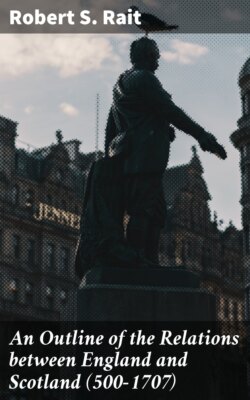Читать книгу An Outline of the Relations between England and Scotland (500-1707) - Robert S. Rait - Страница 4
На сайте Литреса книга снята с продажи.
FOOTNOTES:
ОглавлениеTable of Contents
[1] Spanish and Venetian Calendars of State Papers. Cf. especially the reference to the succour afforded by Scotland to France in Spanish Calendar, i. 210.
[2] Historical Essays, First Series, p. 71.
[3] History of the English People, Book III, c. iv.
[4] History of Scotland, vol. i, p. 2. But, as Mr. Lang expressly repudiates any theory of displacement north of the Forth, and does not regard Harlaw in the light of a great racial contest, his position is not really incompatible with that of the present work.
[5] History of England, p. 158. Mr. Oman is almost alone in not calling them English in blood.
[6] History of Scotland, vol. ii, pp. 393–394.
[7] Instances of the first tendency are Edderton, near Tain, i.e. eadar duin ("between the hillocks"), and Falkirk, i.e. Eaglais ("speckled church"), while examples of the second tendency are too numerous to require mention. Examples of ecclesiastical names are Laurencekirk and Kirkcudbright, and the growth of commerce receives the witness of such names as Turnberry, on the coast of Ayr, dating from the thirteenth century, and Burghead on the Moray Firth.
[8] Cf. Waverley, c. xliii, and the concluding chapter of Tales of a Grandfather.
[9] William of Newburgh states this in a probably exaggerated form when he says:—"Regni Scottici oppida et burgi ab Anglis habitari noscuntur" (Lib. II, c. 34). The population of the towns in the Lothians was, of course, English.
[10] For the real significance of such grants of land, cf. Maitland, Domesday Book and Beyond, Essay II.
[11] Scotland under her Early Kings, vol. i, p. 239.
[12] Annalia, iv.
[13] There is a possible exception in Barbour's Bruce (Bk. XVIII, 1. 443)—"Then gat he all the Erischry that war intill his company, of Argyle and the Ilis alswa". It has been generally understood that the "Erischry" here are the Scottish Highlanders; but it is certain that Barbour frequently uses the word to mean Irishmen, and it is perhaps more probable that he does so here also than that he should use the word in this sense only once, and with no parallel instance for more than a century.
[14] Chronicle, Book II, c. ix. Cf. App. A.
[15] Ibid, Book V, c. x. Cf. App. A.
[16] History of Greater Britain, Bk. I, cc. vii, viii, ix. Cf. App. A.
[17] Scotorum Regni Descriptio, prefixed to his "History". Cf. App. A.
[18] Fasti Aberdonenses, p. 3.
[19] De Gestis Scotorum, Lib. I. Cf. App. A. It is interesting to note, as showing how the breach between Highlander and Lowlander widened towards the close of the sixteenth century, that Father James Dalrymple, who translated Lesley's History, at Ratisbon, about the beginning of the seventeenth century, wrote: "Bot the rest of the Scottis, quhome we halde as outlawis and wylde peple". Dalrymple was probably a native of Ayrshire.
[20] Liber Pluscardensis, X, c. xxii. Cf. App. A.
[21] Scoti-chronicon, XV, c. xxi. Cf. App. A.
[22] Greater Britain, VI, c. x. Cf. App. A. The keenness of the fighting is no proof of racial bitterness. Cf. the clan fight on the Inches at Perth, a few years before Harlaw.
[23] Scotorum Historiæ, Lib. XVI. Cf. App. A.
[24] Rerum Scotorum Historia, Lib. X. Cf. App. A.
[25] Top. Hib., Dis. III, cap. xi.
[26] Britannia, section Scoti.
[27] Mahoun = Mahomet, i.e. the Devil.
[28] The Editor of the Scottish Text Society's edition of Dunbar points out that "Macfadyane" is a reference to the traitor of the War of Independence:
"This Makfadzane till Inglismen was suorn;
Eduard gaiff him bath Argill and Lorn".
Blind Harry, VII, ll. 627–8.
[29] "Far northward in a nuke" is a reference to the cave in which Macfadyane was killed by Duncan of Lorne (Bk. VIII, ll. 866–8).
